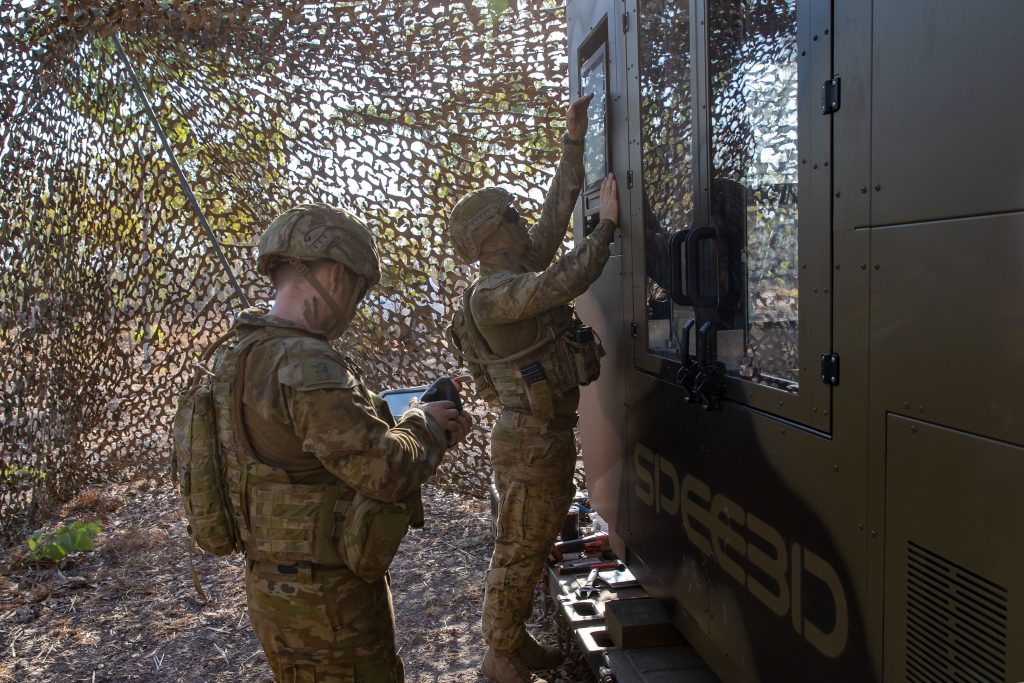Australian metal 3D printer manufacturer SPEE3D has been chosen by the US Navy to supply its ‘MAINTENX’ maintenance technology engagement exercise.
As part of the initiative, SPEE3D’s systems are set to be deployed both at port and by sea, during the US Navy’s ANTX-Coastal Trident 2022 technical demonstrations. Through the R&D program, the US Armed Forces branch aims to assess the potential of metal 3D printing, as a means of carrying out ship battle damage repairs, and reducing its reliance on traditional supply chains at risk of disruption.
“We are thrilled to collaborate with the US Naval Warfare Centers to test and validate our unique metal 3D printing capability,” said Byron Kennedy, CEO of SPEE3D. “We understand their operational challenges both on land and sea, and look forward to strengthening our existing relationships with the US Department of Defense (DoD) as a trusted partner.”

SPEE3D’s Cold Spray technology
Established by engineers Byron Kennedy and Steven Camilleri, SPEE3D is a manufacturer whose business revolves around its proprietary Cold Spray technology. Unlike ordinary metal 3D printing, which relies on high-powered lasers and expensive gasses, the company’s process uses the power of kinetic energy instead, to jet powders with sufficient velocity to deform and fuse them with substrates on impact.
Marketed in the form of its LightSPEE3D and WarpSPEE3D units, the firm’s technology is capable of producing parts up to 1000mm x 700mm in size and 40kg in weight, at speeds it says are 100 to 1000 times faster than traditional metal 3D printers.
So far, the high throughput of these machines has attracted the interest of everyone from on-demand part manufacturers to rocket builders. Early in 2021, service provider 3D in Metal installed a WarpSPEE3D 3D printer at its El Salvador complex, enabling it to better meet Latin American demand for spare metal parts, before SPEE3D gained funding to help develop low-cost 3D printed rocket engines.
Cold Spray technology has also proven adept at meeting military demand for a means of producing spares on-site, out in the field. The Australian Army has been one of the most extensive users of SPEE3D’s systems in such applications, and following a string of successful 3D printing trials last year, Kennedy hailed the “bigger, longer and more remote” tests as a validation of their potential in defense.
Likewise, the US military has shown increasing interest in SPEE3D’s portfolio, with Phillips Federal’s Center of Innovation upgrading to a WarpSPEE3D earlier in 2022. This followed the inaugural Defense Strategies Institute Award for Expeditionary and Tactical 3D Printing Excellence, which the firm won in recognition for its achievements in using its technology to support the US DoD’s mission priorities.

The US Navy’s ANTX-CT trial
Cold Spray technology’s latest military trial will see it deployed as part of ANTX-Coastal Trident, an operational R&D program designed to identify technologies which address US maritime security concerns. Led by the Naval Surface Warfare Center’s Port Hueneme Division, as well as partners like Matter Labs, the 2022 edition of the annual exercises will take place at the Ventura County Naval Base.
In order to pursue its aims of ‘expanding the advantage’ of the naval warfighter and meeting its operational needs via new technologies, the US Navy arm is set to carry out tests of novel approaches to maritime threat mitigation, data-driven decision support, AI, VR, unmanned systems and in-service maintenance later this year.
SPEE3D’s role in the initiative will be to demonstrate the potential of its technology as a portable solution to the latter, that can be deployed as needed to create parts on-demand. According to Kennedy, the firm’s machines are capable of rapidly producing large-scale components “that would otherwise take weeks or even months to manufacture,” while doing so outside of a lab, in hostile environments.
These claims will now be put to the test onboard the US Navy’s Self Defense Test Ship (SDTS), which is currently stationed at Port Hueneme, California, from August 22 to September 2, 2022.

Addressing naval deployability needs
The US Navy has invested heavily in the R&D and utilization of 3D printing technologies, particularly those with the potential to reinforce its supply chain, and enable its service people to produce spare components when deployed at sea.
Desktop Metal subsidiary ExOne, for instance, has been contracted by the Defense Logistics Agency (DLA) to develop a portable 3D printing factory for the US DoD. Set to be housed inside a 40-foot shipping container, the compact production pod is set to contain everything needed to manufacture spares, and be deployable by land, air and sea.
INTAMSYS has developed a similar system for the Royal Netherlands Navy, in the shape of its AMCOD 3D printing mobile repair center. Composed of a FUNMAT HT and two FUNMAT Pro 410 3D printers inside a shipping container, the module is designed to help reduce the dependence of Dutch military vessels on traditional supply chains, as well as minimize any downtime caused by part shortages.
Mid-last year, Aurora Labs also began 3D printing stainless steel maritime components as part of an initiative carried out alongside BAE Systems Maritime Australia. Having been identified as a possible provider of powder bed fusion (PBF) technologies, the firm was charged with producing parts designed for fitting onboard nine Australian Navy frigates, before evaluating their commercial viability.
To stay up to date with the latest 3D printing news, don’t forget to subscribe to the 3D Printing Industry newsletter or follow us on Twitter or liking our page on Facebook.
For a deeper dive into additive manufacturing, you can now subscribe to our Youtube channel, featuring discussion, debriefs, and shots of 3D printing in-action.
Are you looking for a job in the additive manufacturing industry? Visit 3D Printing Jobs for a selection of roles in the industry.
Featured image shows the WARPSPEE3D 3D printer. Image via SPEE3D.


